Since you’re reading this you’re probably a birder, bird photographer or nature lover and have seen your share of “pooping” birds. Well.., mostly it isn’t really poop in the traditional sense – its composition is a little different than many folks think and that’s an adaptation that originated with the shelled egg. First a little background (and I promise not to use the word “poop” again…:
Most mammals excrete their toxic nitrogenous wastes in the form of urea but birds and reptiles produce uric acid instead. There’s good reason for that. Urea is soluble in water and in mammals is excreted in their familiar urine. But birds as developing embryos must survive their time in the egg with their toxic wastes also enclosed within the shell (a problem not faced by mammals). If they produced water-soluble urea it would quickly build to toxic levels within the egg and kill the embryo. So birds produce uric acid instead. Uric acid is insoluble in water and crystallizes out of solution and stored harmlessly within the egg until hatching.
“Thus from an embryonic necessity was born an adult virtue”. Adult birds concentrate and store uric acid within the cloaca before it is voided. Birds can excrete 1 gram of undissolved uric acid in less than 3 ml of water but mammals require up to 60 ml of water to excrete the same amount of urea so this is also a weight-saving device for flight. Water (urine) is heavy – imagine trying to take off or maneuver in flight with your “tank” (urinary bladder, a structure lacking in birds) full of sloshing urine…
Sexual products (sperm and eggs), metabolic wastes (uric acid) and digestive wastes (feces) must all pass through the cloaca (which literally means “common sewer”), a storage chamber opening to the outside at the vent. So birds have only one opening to the outside for elimination of these products while mammals typically have two.
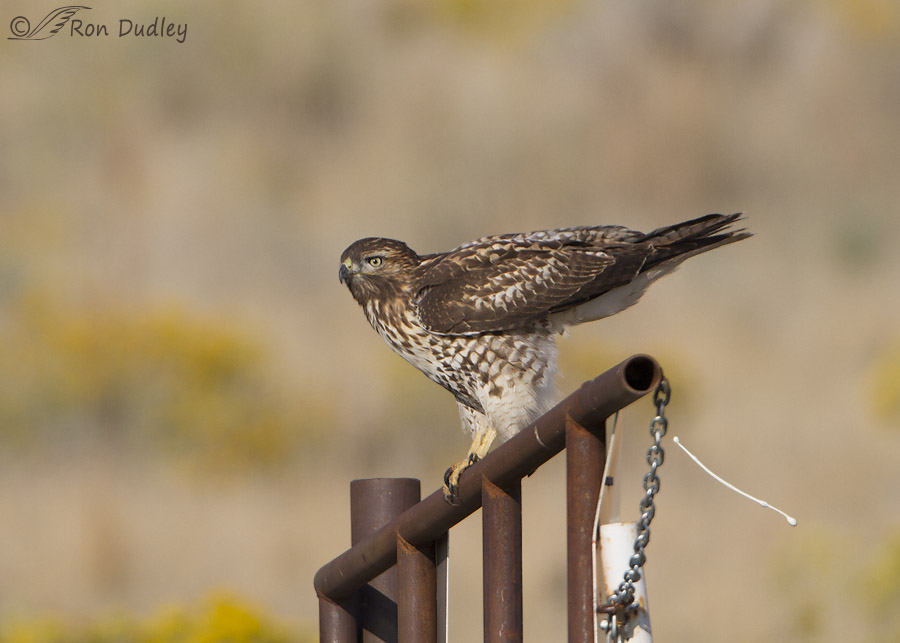
Ok, sorry for the heavy reading but this explains some things we’ve all seen in the field. Birds excrete uric acid in the form of a relatively thick white paste (darker digestive wastes may also be included) instead of water based urine as in mammals.
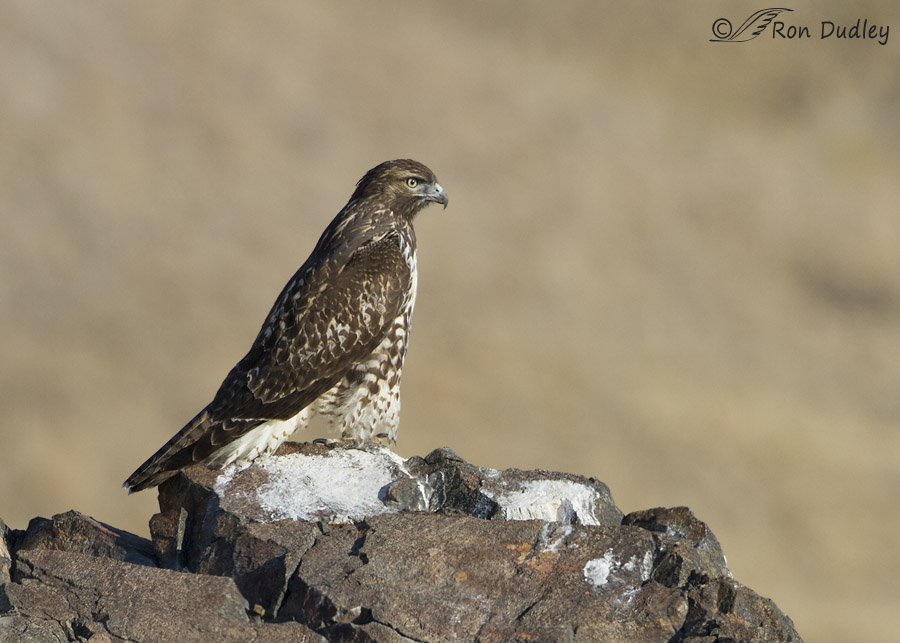
That paste collects on habitual perches and many of us call it “whitewash”. It can be aggravating to photographers (and car owners) because some see it as unsightly (I’m well-known for not being a fan of bright perches in my photos) and because of its insolubility in water it’s incredibly persistent – I don’t think Noah’s floods would wash it away!
This rocky perch, part of a huge boulder on the slopes of Antelope Island’s Frary Peak, is a favorite perch for birds like Red-tailed Hawks, Chukars, Western Meadowlarks, Rock Wrens, Sage Thrashers and Lark Sparrows but I seldom use any photos of birds using the perch because the rock is so heavily stained with whitewash. Several years ago I noticed that even after a huge rainstorm the whitewash had been unaffected so using some bottled water I attempted to scrub away a tiny portion of it as a test. It simply would not come off. Water has often been referred to as the “universal solvent” but obviously even water has its limits.
Several of the following images are soft but I think they’re sharp enough to make my point.
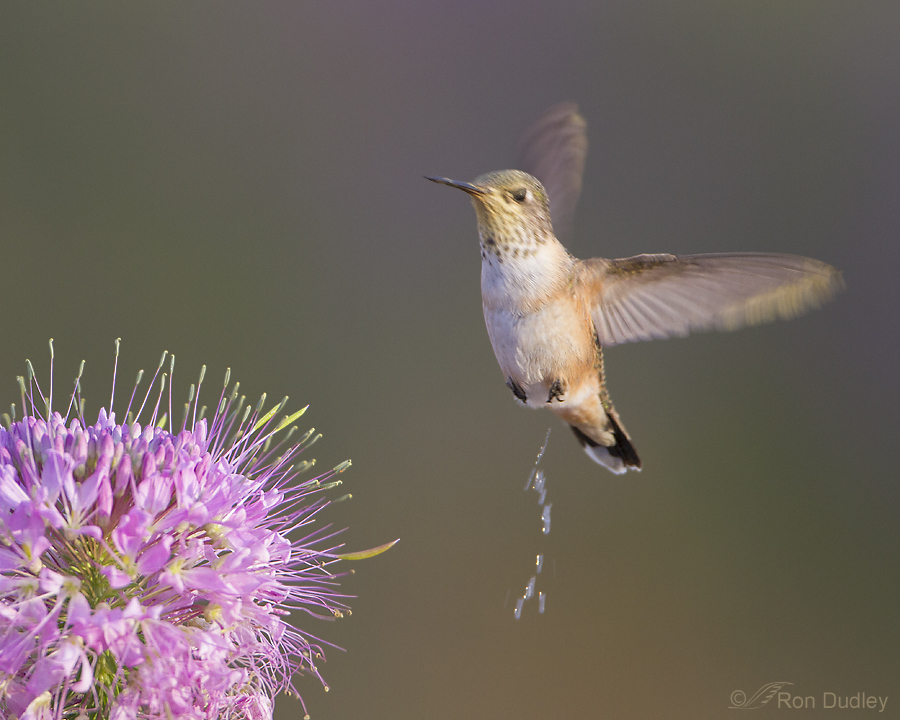
Some birds take in so much water in their diet that excess amounts of it must also be voided – many hummingbirds are a case in point. Flower nectar is mostly water so hummers have to ingest a lot of it to meet some of their nutritional requirements (something that those of us who put out feeders are well aware of). I photographed this one as it was feeding on Rocky Mountain Bee Plant on Antelope Island and just happened to squeeze the shutter as it voided some of that water. It also contains some white uric acid (out of solution of course) but as you can see it’s mostly water.
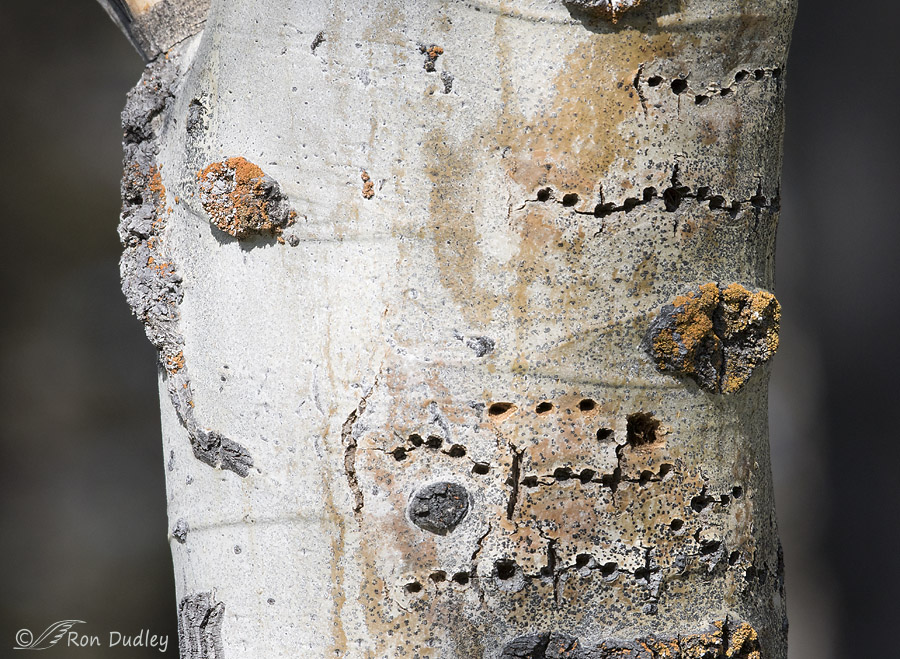
Prior to nesting season the Williamson’s Sapsucker’s diet is made up almost entirely of tree sap harvested at sap wells like you see here (image taken on our last Montana camping trip a few weeks ago).
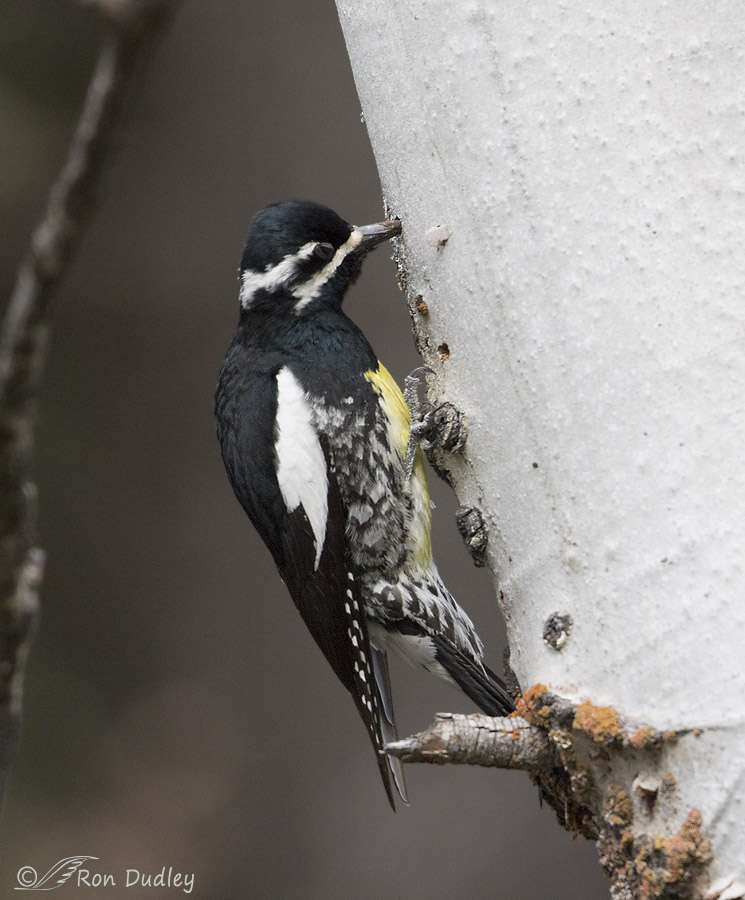
Here you can see the male of the mated pair taking a sap break in-between bouts of defending (or attempting to establish) its nesting territory from the likes of Northern Flickers, Mountain Bluebirds and Red-breasted Nuthatches. Tree sap is also mostly water so…
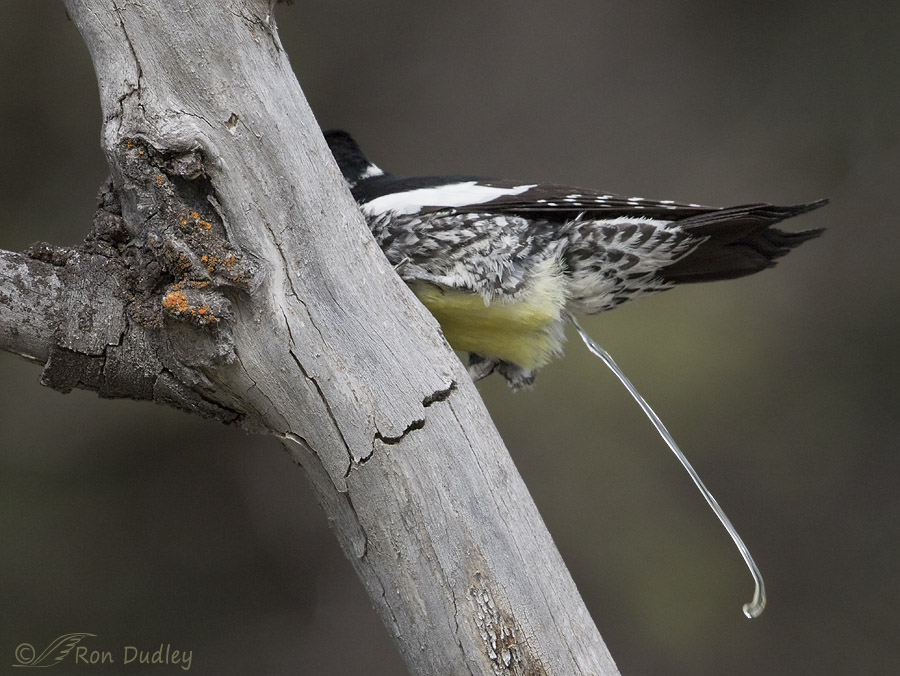
you guessed it, the bird soon voided a big batch it. After the eggs are laid these birds begin to consume lots of ants and at that point their wastes would also include dark indigestible chitin from their exoskeletons.
I hope you’ll forgive or at least tolerate the bio-geekiness of this post. It won’t be for everyone but this stuff fascinates me so I just went with the flow…
Ron



I always learn a lot…cloaca. Thanks for the biology lesson!!
Interesting info and fantastic shots Ron!
Charlotte
‘Going with the flow’ cracked me up. It sounds better than going with the splat though.
Fascinating Ron, and well illustrated. Thank you.
“It sounds better than going with the splat though”
That it does, EC! Thank you.
Hi Ron:
I enjoyed the post – it makes perfect sense, and explains why birds did not evolve as mammals did. To add to your “lesson”, here is a bit of human correlation for you and your readers: human embryos start out with a cloaca as well. During the course of embryological development, specific layers of tissue evolve, forming the separation between the urinary and lower alimentary tracts, so urine and fecal material are processed and excreted separately.
However… sometimes embryological development goes array, or just stops for some reason. It is pretty rare, but some babies are born still with their cloaca, which is usually wide open through the lower abdomen as a “cloacal exstrophy”. In humans this creates a lot of problems, so it requires a very complex surgical repair shortly after birth.
And yes, like many photographers, I love a good poop shot!
“human embryos start out with a cloaca as well”
Yes, they do, Roberta (as do many other mammals I believe). I first learned about embryological cloacas in humans as evidence of recapitulation theory (also called ontogeny recapitulates phylogeny) but that theory has now been largely discredited.
I ran across some reading about human babies born with cloacas while preparing this blog – fascinating stuff.
Like it? As a former parrot owner, it’s something I studied. Heck, one of my dear friends wrote an in-depth article on how to view poop for the health of your flock.
Your friend sounds like my kind’a person, Arwen!
The “biogeekiness” is part of what makes your blog so great!
Thanks, Guy. That’s good news because there’s no question that it’ll always be a part of me…
Boy, Ron – here’s another blog that I just love!! So enjoyed the photos & the “Lesson on Poop”!! As I’ve mentioned before, watching the Berry College Eagle nest for two seasons has given myself & the rest of my fellow Beak Geeks plenty of chances to watch Mom & Dad & the eaglets do their “Aim & Shoot” as I like to call it. (We’ve always marveled at eaglets knowing to go to the side of their nest to do their “business”). What I didn’t know is what you shared w/us today. I LOVE learning everything I can about these gorgeous creatures so I thank you for today’s lesson – keep them coming!!
” keep them coming”
I will, Jo Ann. I like to sprinkle in a post like this occasionally for the variety and for the info we all gain (including me) when I do so. Thanks for the encouragement.
With my continued appreciation, this post is the reason your forum is a cut above…gorgeous photos and so much more.
Thanks for the very kind words, Susan.
Absolutely–” Go with the flow”—-and I really appreciated the lesson–always wondered why you couldn’t scrub that white stuff off !
Whitewash sticks tenaciously to its substrate, doesn’t it Kris? I’ve heard that one of the best ways to deal with it is with a pressure washer but I’ve never tried it.
Ron, I will often find the Great Horned Owls that visit our community in Tucson by looking to the ground for the “big whitewash spot” ;~)
When it’s fresh I’ll always find an owl above it, where I might have missed it among the leaves.
That and when I see an accumulation of Hummingbirds in one area of a tree, there’s often an Owl in the area ;~) They seemed like “strange bedroom fellows” but I know understand the Hummers get a lot of protection from the Owl and are too small/fast for the Owl to bother with.
Thanks as aways for your informative posts! You’re the First email I check every morning, then Mia’s ;~)
“I will often find the Great Horned Owls that visit our community in Tucson by looking to the ground for the “big whitewash spot”
I use the same technique in the field when I’m looking for raptors, Alan, but I’m most often searching elevated rocky perches here in Utah or in Montana.
You are an excellent teacher! Fascinating stuff.
That made my day, Dee. Thanks.
Thanks again for the lesson Ron! Fascinating paste! lol
You’re very welcome, Nancy.
Very, very interesting info! I knew their wastes were combined into one “package”, but didn’t really have a clue to what extent…or the make up of it (too dumb to even wonder). Nature is so doggone AMAZiNG!!! Some birds, like Grackles, seem to leave so much more excreta than other birds the same size. Or maybe it’s where they leave it…like on our windsheild. Never even wondered what happen in the shell…or that both egg and excrement leave through the same opening…thanks for explaining and posting this….
You never see any evidence (chitin, small body parts, etc.) in their poop…maybe some seeds, but that seems to be it. Their ability to fully digest their food must be incredibly efficient…I know some birds, as past postings have illustrated, cast pellets of undigestible parts….
“You never see any evidence (chitin, small body parts, etc.) in their poop”
Actually, you often do, Patty. If you look at a dropping carefully it often (though not always) is composed of a larger mass of white (uric acid) and a darker mass of indigestible waste from the alimentary tract. They combine in the cloaca before being eliminated. There’s often not as much digestive waste as one might expect because many birds expel pellets of fur, bones, chitin etc out their mouth so it never goes through the rest of the digestive tract.
Thanks for taking the time to give us these lessons. It gives us understanding of the behavior of the birds that fascinate us.
Thank you, Marsha.
I love your photos but relish the biology or photography lesson that they illustrate. This is one of my favorite posts and, thanks to your Facebook link, I have shared it with my friends and family.
Share away, Dennis. I appreciate it.
Excellent and very interesting information. Thanks SO much!!
Thanks, Gretchen.
Falcons might consider it to be a “mute” point…
Cheers,
Dick
Dick, I’ve actually often wondered if falcons and perhaps other birds of prey instinctively look for whitewash from smaller birds as a potential pointer toward prey…
Ron,
Perhaps I was stretching it with my “mute” pun. Just thought I’d take a “slice” at it…
Cheers,
Dick
Sorry, Dick, I missed it. I’m a little slow – think I need a nap. Or some coffee. It’s starting to rain again and that always puts me in a fog…
Dick,
Your sense of humor is delightful!
Kate
By the way, Jackson Pollack would be proud of some of the elegant “gestures” you have captured!!!
Ha, funny you should mention Jackson Pollack, Deborah. Several folks over the years have told me I look(ed) like him…
Absolutely fascinating! Most things that “gross us out” as humans are actually wondrous adaptations and full of marvel. As a bird rehabber, I have lots of experience with – yes – poop. It is an important diagnostic tool, among other things. Although I am familiar with most of your interesting (textbook quality) “lesson”, I have only now realized why I can never get the white stuff off my clothes just by wiping with a wet cloth! Thank you for clarifying. A day passed without learning is a day wasted.
“Most things that “gross us out” as humans are actually wondrous adaptations and full of marvel”
I couldn’t agree more, Deborah.
Great. 2 in 1, meaning – a very educational text along with very representative images.
Once a teacher always a teacher.
Thank you for this interesting lesson.
I’m glad you enjoyed it, Jorge. Thank you.
Ron, great shots, so to speak. The hawks sure looked pleased. I did not know about uric acid production in the embryo and its isolation so as not to kill the embryo. Thanks. Great pictures and excellent ornithology discussion. Will be thinking of you when I watch the raptors slice as I walk.
Diana, the evolution of the shelled egg is considered one of the most important in the development of vertebrates – it’s what allowed them to move onto land (shelled eggs don’t dry out when laid in land). But there were huge obstacles to overcome and one of them was a way for the embryo to survive in the egg with its own wastes.
LOL….
Sorry, CJ. I just couldn’t resist that last line…